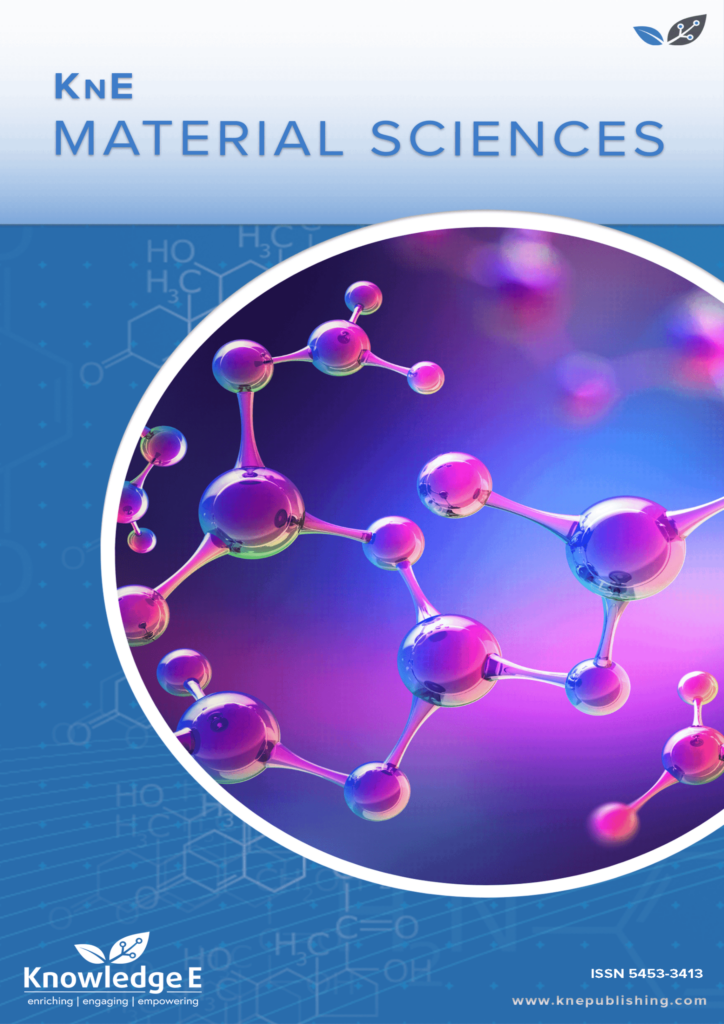
KnE Materials Science
ISSN: 2519-1438
The latest conference proceedings on physical materials, energy materials, electrical materials.
Influence of Solvent Additive 1,8-Octanedithiol on P3HT:PCBM Solar Cells
Published date: Oct 14 2018
Journal Title: KnE Materials Science
Issue title: Sino-Russian ASRTU Conference Alternative Energy: Materials, Technologies, and Devices
Pages: 56-65
Authors:
Abstract:
A facile and efficient route is developed to improve the power conversion efficiency of poly(3-hexylthiophene-2,5-diyl):[6, 6]-phenyl-C61 butyric acid methyl ester (P3HT:PCBM) solar cells by processing solvent additive 1,8-octanedithiol (ODT) in the bulk heterojunction systems. The influence of ODT on polymer surface and inner
morphology, crystallinity, and quantitative molecular miscibility of P3HT and PCBM is studied. The results show that ODT enhances the phase separation of P3HT and PCBM and the P3HT crystallinity, increases the solubility of PCBM in P3HT, and reduces the size of amorphous P3HT domains. A high concentration of ODT induces the formation of a PCBM enrichment surface layer, which is beneficial for the device performance.
Keywords: P3HT:PCBM, ODT, TOF-GISANS, morphology, miscibility
References:
[1] Gholamkhass, B., Peckham, T. J., and Holdcroft, S. (2010). Poly(3-hexylthiophene) bearing pendant fullerenes: Aggregation vs. self-organization. Polymer Chemistry, vol. 1, pp. 708–719.
[2] Chen, H. Y., Yang, H., Yang, G., et al. (2009). Fast-grown interpenetrating network in poly(3-hexylthiophene): Methanofullerenes solar cells processed with additive. Journal of Physical Chemistry C, vol. 113, pp. 7946–7953.
[3] Razzell-Hollis, J., Tsoi, W. C., and Kim, J. S. (2013). Directly probing the molecular order of conjugated polymer in OPV blends induced by different film thicknesses, substrates and additives. Journal of Materials Chemistry C, vol. 1, pp. 6235–6243.
[4] Cho, S., Nho, S. H., Eo, M., et al. (2014). Effects of processing additive on bipolarfieldeffect transistors based on blends of poly(3-hexylthiophene) and fullerene bearing long alkyl tails. Organic Electronics, vol. 15, pp. 1002–1011.
[5] Schaffer, C. J., Schlipf, J., Indari, E. D., et al. (2015). Effect of blend composition and additives on the morphology of PCPDTBT:PC71BM thin films for organic photovoltaics. ACS Applied Materials & Interfaces, vol. 7, pp. 21347–21355.
[6] Müller-Buschbaum, P., Kaune, G., Haese-Seiller, M., et al. (2014). Morphology determination of defect-rich diblock copolymer films with time-of-flight grazingincidence small-angle neutron scattering. Journal of Applied Crystallography, vol. 47, pp. 1228–1237.
[7] Kampmann, R., Haese-Seiller, M., Kudryashov, V., et al. (2004). The potential of the horizontal reflectometer REFSANS/FRM-II for measuring low reflectivity and diffuse surface scattering. Physica B, vol. 350, pp. E763–E766.
[8] Kampmann, R., Haese-Seiller, M., Kudryashov, V., et al. (2006). Horizontal ToFneutron reflectometer REFSANS at FRM-II Munich/Germany: First tests and status. Physica B, vol. 385–386, pp. 1161–1163.
[9] Yao, Y., Hou, J., Xu, Z., et al. (2008). Effects of solvent mixtures on the nanoscale phase separation in polymer solar cells. Advanced Functional Materials, vol. 18, pp. 1783–1789.
[10] Li, G., Shrotriya, V., Huang, J., et al. (2005). High-efficiency solution processable polymer photovoltaic cells by self-organization of polymer blends. Nature Materials, vol. 4, pp. 864–868.
[11] González, D. M., Körstgens, V., Yao, Y., et al. (2016). Improved power conversion efficiency of p3Ht: PCBM organic solar cells by strong spin-orbit coupling-induced delayed fluorescence. Advanced Energy Materials, vol. 5, p. 1401770.
[12] Ruderer, M. A. (2012). Morphology of polymer-based films for organic photovoltaics. PhD thesis, Technische Universitat Munchen, Munich, Germany.